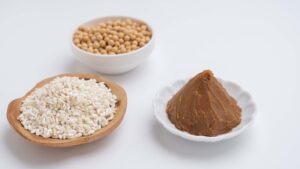By Laurie Post, Ph.D.
A recent article in the Journal of Food Safety by authors at the Federation University in Australia reviewed the processes used in the production of Japanese rice koji and miso and developed a hazard assessment for these fermented foods.
Miso is a traditional fermented soybean paste made for thousands of years. The most common type of miso is made from rice koji, salt, and soybeans using a two stage fermentation process. The first step is the production of koji where rice is fermented with a mold such as Aspergillus oryzae at 30°C for 48 h. The koji and salt are then added to boiled soybeans and fermented by yeasts and bacteria for 2 to 24 months. Koji and miso are increasing in popularity in western countries where contemporary miso varieties are not pasteurized as consumer demand is for more natural products containing live microorganisms. While correctly prepared fermented foods are rarely associated with foodborne illness outbreaks, there have been several reports of illness. These were primarily due to pathogenic microorganisms introduced into the products from external sources such as raw materials or the processing environment. Hygiene and fermentation conditions must be carefully monitored to ensure food safety.
The authors point out that many of the production steps in the manufacture of koji and miso do not fit into contemporary food safety guidelines. Although a reduction in pH is a typical food safety hurdle for fermented foods, this does not apply to non-acidic foods such as koji or miso. Use of a certified safe mold as the starter culture and monitoring appropriate temperatures to ensure prolific growth of the mold (and to minimize growth of unwanted bacteria) are requirements for the safe production of rice koji. An optimized salt content and reduced water activity (Aw) is a food safety hurdle in the production of miso. Focusing on the quality of ingredients and hygienic practices along with the development of standardized
fermentation conditions, would also assist in safe production of these fermented foods. The authors conclude that research on unpasteurized koji and miso is needed to determine optimized temperatures, pH and Aw levels, and salt concentrations during the fermentation process that would assure these fermented foods comply with food safety requirements.



